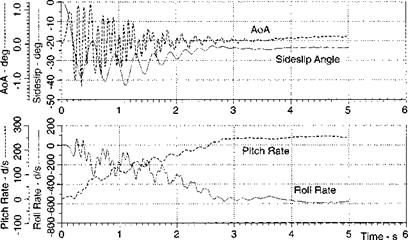Aerodynamically induced rolling moment
7.5.2.3 The open-loop horizontal turn of Fig. 7.4 will serve as a test case. It is generated by 10-deg yaw control and is typical of a 50-g (peak) intercept trajectory.
First, we study the aerodynamic rolling moment and its effects on the roll excursions of the missile. Then we trace the inertial coupling of roll into the pitch channel, and finally create a hypothetical case without the induced rolling moment to highlight the lack of transient dynamics.
The rolling-moment equation is the first of the attitude equations, Eq. (7.85):
1 1
p = —L = —(Lpp + LSp8p + Lwvwv Л—— )
11 1]
with the key nonlinear derivative Lwv coupling vertical and lateral perturbations into the roll channel. The nondimensional equivalent of this derivative is Q0<l. For our prototype missile the Qo derivative is plotted against fi for various Mach numbers in Fig. 7.5. As fi increases, so does the roll coupling, particularly in the transonic regime.
|
Fig. 7.5 Cia derivative vs /3 and Mach. |
For the test trajectory of Fig. 7.4, the incidence angles and pitch and roll rates are plotted in Fig. 7.6. The severe lateral turn is executed with sideslip angle f5 as high as —40 deg. In the presence of even small a, a large roll rate builds up, leveling out at —600 deg/s.
Inertial coupling enters through the second of the attitude equations, Eq. (7.85):
. rrp(I2 – h) , M —h~+h
The sustained yaw rate rr of the lateral turn multiplies with the roll-rate perturbations p and generates pitch-rate perturbations q that grow to 250 deg/s.
Figure 7.6 traces both the aerodynamic and inertial coupling from the roll to the pitch channel. As a hypothetical exercise, we can ask the question, what happens
|
Fig. 7.6 Induced aerodynamic roll-rate coupling into pitch channel. |

![]()
![]()
![]()

 |
CCo
.c
if the aerodynamic rolling moment is absent? I deleted the roll coupling terms in the simulation, repeated the test case, and plotted the result in Fig. 7.7.
Without the induced rolling moment the roll rate is zero, and the pitch rate reflects only the small angle-of-attack transients without any inertial cross coupling.















